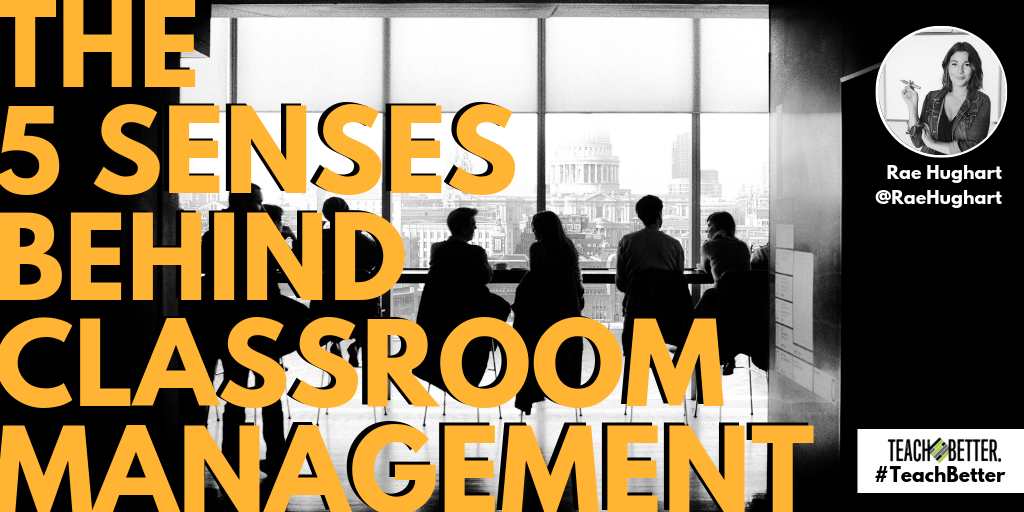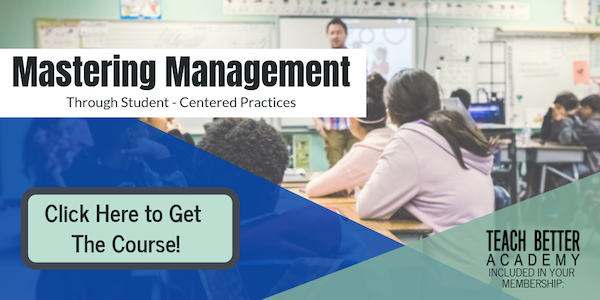In This Post:
- Classroom management blogs are filled to the brim with strategies and techniques to help students operate at their highest potential within the classroom environment.
- One idea often not discussed – the element of how a classroom’s physical space adds to classroom management success.
- Think of your favorite place to work; what makes it your favorite? How it appeals to your 5 senses!
- Focus on how your classroom environment appeals to your students’ 5 senses: Sight, Sound, Taste, Smell, and Touch
The way educational institutions are managed has changed drastically as technology developed. From the implementation of text messaging solutions like the ones available on this website to smart boards changing the way lessons are taught. All this change can make it hard for a teacher to manage their classroom in the best way possible. Classroom management blogs are filled to the brim with strategies and techniques to help students operate at their highest potential within the classroom environment. Reward systems, student voice, and the display of classroom expectations fill a google search page when we begin to hunt for a new strategy to reach our students more effectively in the classroom. But, one idea often not discussed is the element of how a classroom’s physical space adds to classroom management success.
No, this will not be another flexible seating blog! Rather, let’s focus on how you can appeal to a student’s 5 senses to support your ideal classroom management.
Let’s Imagine
Imagine, you are on Spring break. You open up your calendar for the day and notice your children are going to your sister’s house to spend the day with the cousins, your spouse has a jam packed day, the dogs are at the groomer for the afternoon, and you already cleaned the house and caught up on Netflix earlier this week. You actually have time to look over your classroom to-do list and knock something off! (Victory!)
Want students to enter your room energized and ready for the day? Try some rock & pop playlists on Spotify! Click To TweetSo, where do you head to work? Home office? Favorite coffee shop?
For me, I’m headed to Zion Coffee in Peoria, IL. It’s a modern take on a coffee shop atmosphere, with fun and funky furniture, green plants, incredible coffee, fresh food, floor to ceiling windows, light music, and strong Wifi.
But why do we enjoy these ideal work spaces? Answer : They appeal to our 5 senses.
- See : I love the Zion Coffee modern take on a clean and tidy space. The mix of light wood, clean white furniture, natural light, and bright green plants makes for a fun environment to spend the day working within.
- Hear : This coffee shop stays pretty quiet. While many visitors choose to catch up with friends, the vast majority of this shop’s patrons are working individually on their own passions. Periodic coffee machine grumbles interrupt the soft instrumental music. It seems to be just enough noise for someone who enjoys minimal distractions, or the perfect blending for someone eager to pop in headphones and jam out to their own tunes.
- Smell : If you have not enjoyed the smell of fresh coffee, you are missing out on a key happiness of life!
- Feel : The seating has a variety of options for anyone stopping in for a quick “Cup of Joe” to someone camping out for the day, but I also always enjoy the flow of fresh air from the open windows. In the summer, the AC Company would have fitted a system so we would get constant cool air cooling us down from the sun’s heat. Did I mention the ease of finding an outlet? They are everywhere. Talk about a stress free space.
- Taste : The food and coffee are to die for… Period.
Duplicating this in the Classroom
How can we duplicate this for our own student learning spaces? Start with the “sense” that comes most easily to you (this may be different for everyone) and explore the first steps below!
[scroll down to keep reading]Appeal to a Student’s Sense of Sight
I am no interior designer, but there is value in evaluating how your physical space can make students feel. Have you ever been in a classroom filled floor to ceiling with posters, words, mathematical equations, and student work? While these educators carry the best of intentions, research continues to prove this can be overwhelming.
May educators view these environments as helpful … “everything a student would need is on the wall!”… but in reality, the more you post on your classroom walls, the less students are able to compartmentalize which information is helpful for their success.
Consider what the message is you really want students to see when they experience your classroom? Make that the focus!
Consider lighting! Did you know light has an enormous effect on our ability to work on strenuous tasks? I mean, I know I am most drawn to work spaces with natural light. However, most of the time we have little control over the natural light we can stream into our classrooms.
So, whats a solution? Consider lamps, dimmers, and other light options for your students work space. Remember, you want to avoid flickering lights, as this can affect the eye health and productivity of your students, so be sure to visit this page to find a professional electrician if this is a problem that you run into. When it comes to changing your lighting situation, it is also the perfect time to navigate the possibility of how colored lights can add to productivity. Did you know the color red can boost performance on detail-oriented tasks, such as memory retrieval and proofreading by as much as 31 per cent compared to blue colors?
Conversely, for creative tasks such as brainstorming, blue environments have proven to prompt students to produce twice as many creative projects. My favorite stat? Green light has proven to relax the eyes and add to the tranquility of a space.
Now, don’t go replace all your light bulbs! Rather, explore the colors you may want to use within your space.
Appeal to a students Sense of Touch
What does a student touch while learning in your classroom? Some common answers may relate to seating, writing utensils, and learning manipulatives. What control do you have over these items?
I recently spoke on the phone with a teacher struggling with how to manage handing out and collecting supplies. During the conversation, she said, “I just feel like it’s not even worth having students do the activity with all this concern for materials. I’ll either just skip it or find a way to do it on the computer.”
Here is your reminder for those who may need it, having students physically interact with their learning is a major element of some students’ learning material. Therefore, don’t settle for poor instruction because finding a solution for a management element of your classroom is “too tricky!” These things are worth brainstorming!
Consider checklists, student leaders, and communicating the “Why” behind students’ interaction with certain elements of the classroom. Whether it is a new seating option, or a new learning maniplitive, you can find a way to make it purposeful and manageable in your classroom!
Appeal to A Student’s Sense of Smell
The sense of smell is one of the most under-rated senses in the classroom. However, smell can actually be one of the most valuable senses to tap into throughout learning! Science has shown a student’s interaction with a smell during learning and then again when asked to prove mastery can positively impact a student’s memory by 80%. And yet, most of us leave this out of our classroom.
Consider how your space smells. Yes, every school has different limitations with candles, sprays, and diffusers, but don’t let these safety concerns limit your ability to use a student’s sense of smell to help learning or calm emotions. Rather, we just need to explore ways to use it purposefully and safely.
During the next “big assessment” or “high stress” day, consider having a lavender sent in your classroom to calm any nerves. During your next “major lesson” touching on a large idea for the unit, share an orange scent to wake up your students! Then, incorporate the smell again on an evaluation day. Try it out!
Appeal to A Student’s Sense of Sound
Noise in a classroom is always tricky. However, appealing to a student’s sense of sound can have a large effect on the classroom environment you set – and therefore the classroom management strategies you need.
It’s been shown that the type of music playing during work time can have an influence on a person’s ability to learn. Did you know, if you are learning something new, words should not be used in your music choice?
I am sure you’ve noticed this before, while you were trying to compose an email or learn a new skill, unfamiliar songs with words can become distracting. During these times, throw on either a tune you are familiar with, or a song without words.
On the flip side, if you are doing a repetitive task, or one in which you are not “creating” new content, songs with words can have a positive impact on your focus. Noise and music can make a huge impact in your success!
Want students to enter your room energized and ready for the day? Try some rock & pop playlists on Spotify! Looking for a relaxed classroom environment? Set your playlist to instrumental music. Are your students not large string quartet fans? Search for instrumental pop or instrumental rap for fun beats!
Appeal to A Student’s Sense of Taste
The sense of taste is always a struggle for classrooms, because it is a consumable. However, no matter how challenging, taste can have a massive impact on the mood and learning success of students. How does this help with your management? The more comfortable and motivated a student is, the fewer hurdles you may experience throughout your day.
Consider using mints, small hard candy, or hot coca mix in the classroom. Similar to the sense of smell, the connection to the taste of something can positively impact the mood and memory of your busy learners!
Conclusion
Your choice to incorporate students’ senses can impact the success of your classroom management. Consider one of the tips above and strive to reach your students more deeply!
About Rae Hughart
Rae Hughart is a Middle-Level Math and Writing Educator in Illinois and the Director of Training and Development for Progressive Mastery Learning, LLC. In 2017, Rae was honored with the Illinois State University Outstanding Young Alumni Award – inducting her into the University Hall of Fame.




